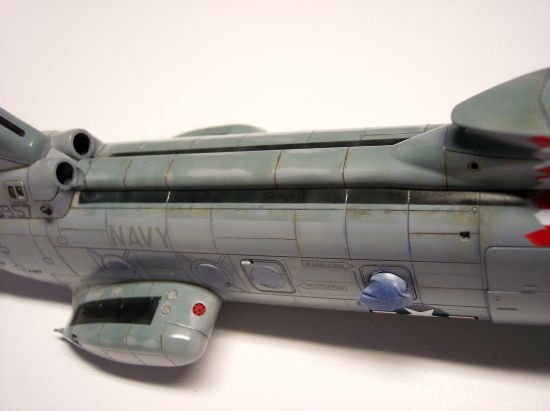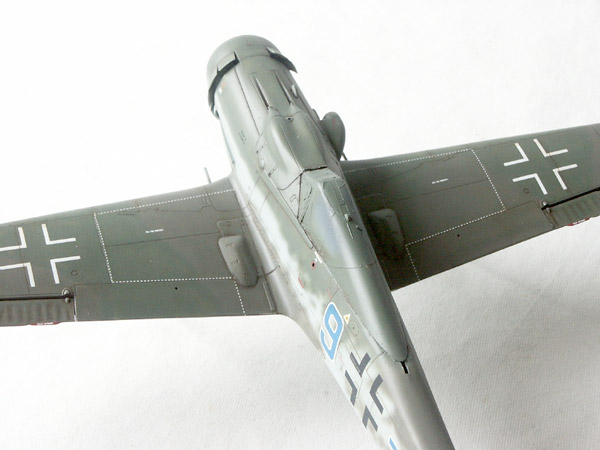General Aircraft
This forum is for general aircraft modelling discussions.
This forum is for general aircraft modelling discussions.
Hosted by Jim Starkweather
Washing Panel Lines?
goldwizard

Joined: February 12, 2005
KitMaker: 128 posts
AeroScale: 0 posts

Posted: Saturday, June 11, 2005 - 06:26 AM UTC
Can anyone tell me a simple method on how to wash panel lines please.
Posted: Saturday, June 11, 2005 - 09:17 AM UTC
hi joe, the method i like to use is instead of using a wash, use a propelling pencil, the way i do it is this,get yourself a propelling pencil with the smallest diameter lead (i use a 3mm one and havent seen any smaller than this) use some fine sandpaper to put an edge on the lead (think of a chisel) and just "draw" it along the lines, it will bring your lines out nicely. here is a pic of an arado 234 that i used this technique on.



mother

Joined: January 29, 2004
KitMaker: 3,836 posts
AeroScale: 1,036 posts

Posted: Saturday, June 11, 2005 - 09:31 AM UTC
Hey Joe I like to use a oil wash. After painting my aircraft i'll clear coat it for washing and decaling. Taking a pea size amount of oil and thinning it down with a oil thinner. There are many brand of thinners out there, but I like the odorless kind. With a small brush dip into your wash and dab it into the panel. It will flow into the lines. It may look a mess, but that's ok. Let it dry 2-3 hours then using a q-tip wip the panel lines lightly in the direction of flight. After a few time you'll get the hang of it. It really is pretty easy...
Here is a pic of a washed and weather aircraft before dullcoating

Good luck to you....
Here is a pic of a washed and weather aircraft before dullcoating

Good luck to you....
Bk27

Joined: February 17, 2005
KitMaker: 92 posts
AeroScale: 0 posts
Posted: Saturday, June 11, 2005 - 09:54 AM UTC

mother

Joined: January 29, 2004
KitMaker: 3,836 posts
AeroScale: 1,036 posts

Posted: Saturday, June 11, 2005 - 10:08 AM UTC
Here's the working link.
http://www.aircraftresourcecenter.com/tnt1/001-100/TNT026_Chalk_Washes/tnt026.htm
http://www.aircraftresourcecenter.com/tnt1/001-100/TNT026_Chalk_Washes/tnt026.htm
Posted: Saturday, June 11, 2005 - 05:55 PM UTC
Quoted Text
Here's the working link.
http://www.aircraftresourcecenter.com/tnt1/001-100/TNT026_Chalk_Washes/tnt026.htm
i was going to post that link , because i have that article printed out somwhere, but i forgot where it originally came from!


procrazzy

Joined: November 28, 2004
KitMaker: 359 posts
AeroScale: 0 posts
Posted: Saturday, June 11, 2005 - 11:14 PM UTC
Mal (holdfast) wrote an article on washes:
https://armorama.kitmaker.net//features/335
I get a 50/50 mix of raw umber and ivory black. Put pea sized blobs of each in a plastic milk bottle top (got that tip form Mals article) Fill the lid with white sprit. Mix it all together and you should be left with a very thin mixture of very dark brown paint. DO NOT use the water soluble oil paints or acryllic oil paints because thease do not give you cappilary action, wather has too much surface tension.
cheers
Philip
https://armorama.kitmaker.net//features/335
I get a 50/50 mix of raw umber and ivory black. Put pea sized blobs of each in a plastic milk bottle top (got that tip form Mals article) Fill the lid with white sprit. Mix it all together and you should be left with a very thin mixture of very dark brown paint. DO NOT use the water soluble oil paints or acryllic oil paints because thease do not give you cappilary action, wather has too much surface tension.
cheers
Philip
Posted: Sunday, June 12, 2005 - 04:35 AM UTC
Here's a live link to my article.
Mal's wash article
The trick for washes is to make sure you protect the paint first. I use Klear (found in any large food chain store). Here's a link to my article on hand brushing Klear (the usual method is to spry it but it dries fast and I don't want this in my airbrush)
The Future is Klear
Once the surface is protected you can abuse it quite a lot Some modellers apply decals after the wash. This IMHO gives the model a false look, a coat or 2 of Klear over them protects them as well. (I have an article on decals as well
Some modellers apply decals after the wash. This IMHO gives the model a false look, a coat or 2 of Klear over them protects them as well. (I have an article on decals as well  )
)
There are many ways to apply washes and I have probably tried most of them. Oil washes seem to offer the greatest flexability. I never use straight black and I always mix the wash without refering to any previous mix. On brown/green camoflaged aircraft I generally use a dark brown colour. On grey camo I use a dark grey or grey brown mix. I also use a different mix on the underside, sometimes I will simply darken this for the uppersurfaces, sometimes I mix a different colour. I'm just about to wash a 1/48 Lysander, the undersurface, Sky, will receive a wash of Davy Grey (a grey brown) this will be darkened with Raw Umber or Burnt Umber for the uppersurfaces.
The latest model to receive a wash was my Focke Wolf FW190D-9, Here's a pic after the matt coat was added.

Mal
Mal's wash article
The trick for washes is to make sure you protect the paint first. I use Klear (found in any large food chain store). Here's a link to my article on hand brushing Klear (the usual method is to spry it but it dries fast and I don't want this in my airbrush)
The Future is Klear
Once the surface is protected you can abuse it quite a lot
 Some modellers apply decals after the wash. This IMHO gives the model a false look, a coat or 2 of Klear over them protects them as well. (I have an article on decals as well
Some modellers apply decals after the wash. This IMHO gives the model a false look, a coat or 2 of Klear over them protects them as well. (I have an article on decals as well  )
)There are many ways to apply washes and I have probably tried most of them. Oil washes seem to offer the greatest flexability. I never use straight black and I always mix the wash without refering to any previous mix. On brown/green camoflaged aircraft I generally use a dark brown colour. On grey camo I use a dark grey or grey brown mix. I also use a different mix on the underside, sometimes I will simply darken this for the uppersurfaces, sometimes I mix a different colour. I'm just about to wash a 1/48 Lysander, the undersurface, Sky, will receive a wash of Davy Grey (a grey brown) this will be darkened with Raw Umber or Burnt Umber for the uppersurfaces.
The latest model to receive a wash was my Focke Wolf FW190D-9, Here's a pic after the matt coat was added.

Mal
Rocketeer

Joined: April 04, 2004
KitMaker: 51 posts
AeroScale: 6 posts

Posted: Sunday, June 12, 2005 - 08:52 AM UTC
If the model is finished with enamals, you can use acrylic paint. The fomula is 2 parts acrylic paint, 3parts of ivory dishwashing lotion and 5 parts water. Brush it on liberally. After half and hour use a Q-tip to remove the excess. the crylic stays in the panel lines. The dishwashing lotion is to break surface tension. It works best on models witha gloss finish or over Future.I keep a bottle of the mixed black and dark gray in my paint box and are always using them.
 |

















